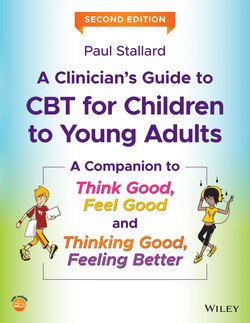Читать книгу A Clinician's Guide to CBT for Children to Young Adults - Paul Stallard - Страница 19
The competencies to deliver child‐focused CBT
ОглавлениеThere are many materials and structured workbooks available which provide helpful ideas about how CBT can be undertaken with children and young people. These include specific manuals such as the Coping Cat programme for young people with anxiety (Kendall 1990); How I Ran OCD Off My Land (March & Mulle 1998), and the Adolescent Coping with Depression Course (Clark et al. 1990). In addition, there are materials to help young people with social skills problems (Spence 1995) and chronic fatigue syndrome (Chalder & Hussain 2002) and anxiety and depression prevention programmes such as Friends for Life (Barrett 2010). There are also books that provide practical ideas about how CBT can be adapted for use with children and young people (Friedberg & McClure 2015; Fuggle et al. 2012; Stallard 2019a) and how CBT can be used as a modular approach which flexes according to how the young person responds (Chorpita 2007). Finally, there are self‐help books for parents to help them overcome their child’s fears or worries (Cartwright‐Hatton et al. 2010; Creswell & Willetts 2018) or to help their depressed teenager (Reynolds & Parkinson 2015)
Such good quality child‐friendly materials make available many helpful ideas about how to introduce and use specific CBT strategies with children and young people. However, comparatively less attention has been paid to how these techniques are used, that is, the process of undertaking CBT with children, adolescents, and young adults. Attending to the process of CBT is essential and ensures that the theoretical model and the core principles that underpin CBT are preserved. This will ensure that CBT is used in a coherent and theoretically robust way thereby avoiding a simplistic approach in which individual strategies are used in a disconnected and uninformed way.
Think Good, Feel Good (Stallard 2002a, 2019a) and Thinking Good, Feeling Better (Stallard 2019b) provide a number of practical ideas about how some of the specific techniques of CBT could be conveyed to and adapted for use by children, adolescents, and young adults. This book looks behind these strategies to focus upon the process that underpins their use. This book is not intended to be prescriptive and does not advocate a particular style. Instead it aims to promote awareness of some of the key issues that need to be considered and integrated into CBT in a way that is engaging and helpful for the young person and their carer whilst maximising the effectiveness of the intervention.
